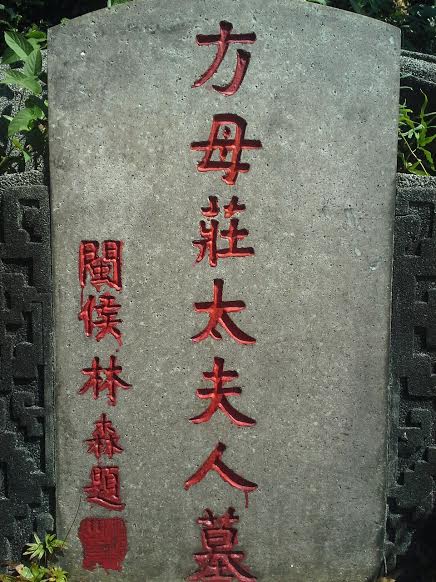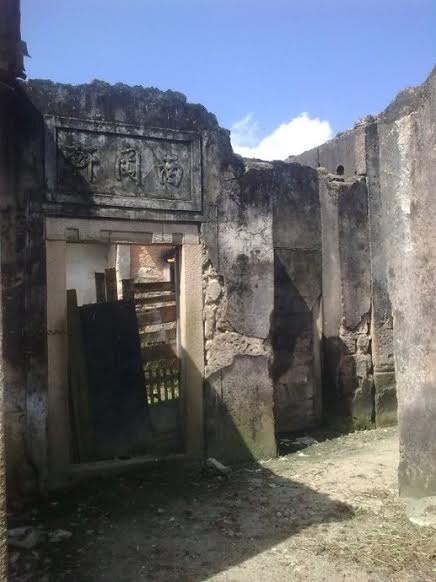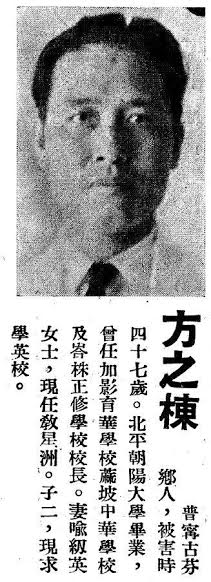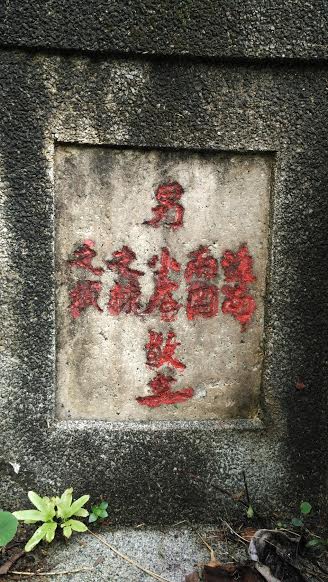Mdm Chng of the Pang Family
0
Mdm Chng of the Pang Family – A Mother of Journalists, Educationists and Revolutionaries
by Ang Yik Han

The tombstone of Mdm Chng, who died in 1936 at the age of 77. The characters on the tombstone were written by Lin Sen, KMT Chairman. (photo Yik Han)
Located at Hill 4 in Bukit Brown, the Teochew style tomb of Mdm Chng of the Pang family (方母莊太夫人) is simple and nondescript. A sharp-eyed observer will notice however that the calligraphy on the tombstone came from the hand of Lin Sen (林森), Chairman, of the ruling pre war Nationalist government in China.
Another sign of her family’s close connection to the Kuomintang was the fact in her obituary in the Nanyang Siang Pau, she was described as the mother of a martyr. This was in reference to her second son, Pang Nam Gang (方南岡), whose story was recorded in Feng Ziyou’s “Anecdotal History of the Revolution《革命逸史》” published in 1948.
Although two of Mdm Chng’s sons passed away before her, the names of all her sons were inscribed on her grave: Siao Cheok少石 (deceased), Nam Gang 南岡 (matyred), Chee Dong 之 棟, Huai Nam 懷南, Chee Cheng 之楨. Also present were the names of two daughters, though her obituary only mentioned one surviving daughter.
Pang Nam Gang had a good grounding in classical Chinese education. However, he spurned the traditional path of becoming a mandarin and chose to pursue his studies in Japan. There, he joined the Tongmenghui. Deeply committed to overthrowing Manchu rule, he devoted his time outside of studies to learning how to make bombs.
In 1905, Pang and eleven of his compatriots in Japan were ordered by Sun Yat-Sen to return to China to assist in the Huang Gang uprising in the Teochew region. Injured while preparing bombs, he was brought to Hong Kong and hospitalised, hence missed out on the action. When the uprising petered out, Pang decided to join his uncle who was a local governor in Gansu, with the intention of seeking opportunities to incite the local Hui people to rise against the Qing. His uncle was initially pleased to see his nephew, but flew into a rage when word reached him that Pang was a revolutionary. Locked up by his uncle, Pang escaped with the help of other relatives, stealing two horses and riding to Hankou, where he sold the horses and boarded ship for Japan to continue his studies. Eventually, he made his way to Penang where he became the editor of the Kwang Wah Yit Poh newspaper which was linked to the Tongmenghui.
The young revolutionary could not sit still for long. When news of the successful 1911 uprising in Wuhan reached the Nanyang, Pang rushed back to China where he raised a fighting force in his home county of Pho Leng. When Yuan Shikai was elected the first President of the nascent Chinese Republic, Pang felt that Yuan could not be trusted as he had too many links with the old regime. Disgruntled, he returned to Penang where he took up his old job at the newspaper.
Pang’s worst fears came true in 1915 when Yuan Shikai assumed the title of Emperor. This time, he could no longer abide the situation and returned to China again to fan the flames of revolution. Unfortunately, he was captured in Macau by Yuan Shikai’s agents and smuggled across the border and imprisoned. At first, he assumed a false identity and did not divulge any information even under torture. However, his fervent preaching of revolutionary ideas to his fellow prisoners gave him away and he was summarily executed. So perished a martyr of the Chinese Revolution at the age of 29.

Photo of Pang Nam Gang (reproduced from the book “The Teochews in Penang: A Concise History” by Mr Tan Kim Hong)

The house of Pang Nam Gang in Pho Leng (taken from the site 方益森的博客 http://blog.sina.com.cn/s/blog_756c1ab90101ipv2.html)
Mdm Chng’s obituary also mentioned that her three surviving sons were active in the areas of journalism, education and social works. Her youngest son, Pang Chee Cheng (方之楨), was in the limelight as well for his involvement in politics. A journalist, he was a KMT cadre who actively canvassed support for the party as one of the main committee members of the Nanyang branch headquarters.
In 1930, Sir Cecil Clementi became the Governor of the Straits Settlements. He had a dislike of the KMT due to its instigations of strikes during his previous posting in Hong Kong. On the day that he arrived and assumed office in Singapore, it was unfortunate that the KMT Nanyang branch headquarters chose to hold its general meeting at the same time.
One of the first acts of the Governor was to summon the KMT representatives to his office where he told them in no uncertain terms that the KMT was not allowed to operate local branches in the Straits Settlements and Malaya. A few months later, the Governor upped the ante by issuing orders to deport Pang Chee Cheng and another KMT stalwart; well aware of the situation, they left on their own for China first.
Quiet diplomacy between the British and Chinese governments behind the scenes eventually led to the deportation orders being rescinded. In later years, Pang Chee Cheng was based largely in China where he was active in the Overseas Community Affairs Council (僑務委員會) set up by the Nationalist government.
Pang Chee Cheng often met with renowned personalities of the day. So it was that when the Indian poet Tagore visited in 1927, Chee Cheng arranged for him to travel to Muar and visit Zhonghua School (中華學校, a forerunner to today’s 中化), where Tagore was received by his brother Pang Chee Dong (方之棟) who was the principal then. A graduate of a university in Beijing, Chee Dong was successively principals of Chinese medium schools in Kajang, Muar and Batu Pahat. In 1933, he may have worked as editor of a Chinese newspaper in Rangoon as well.
After the Japanese invaded, he perished during Sook Ching in Singapore, leaving behind his widow and 2 sons.

A short biography of Pang Chee Dong in the 8th anniversary commemorative publication of the Nanyang Pho Leng Hui Kuan published in 1948.
The fourth son Pang Huai Nam (方懷南) was the first editor of Nanyang Siang Pau (南洋商報) established by Tan Kah Kee in 1923. Slightly less than a month into its publication, he left the newspaper as the Straits Settlements authorities found his writing too political for their liking. He was also a committee member of the Poit Ip Huay Kuan and principal of Choon Guan School. It was mentioned in Phua Chay Leong’s “The Teochews in Malaya” that he shared the same sad fate as his elder brother Chee Dong during Sook Ching.
Mentioned as well in Mdm Chng’s obituary was one of her grandsons, Pang Say Hua (方思法). Born in Singapore to her eldest son, he was “fostered” to his uncle Pang Nam Gang; his father was convinced that his second brother would come to no good end with his revolutionary ways and hence it was better that he had a son to his name. Pang Say Hua went back to China to study and subsequently became a signaler in the Nationalist Army. He was one of the many caught up in the tumult of the times. Due to his background, he suffered after the Communists took over, being imprisoned for over ten years. After his release, he worked at various jobs and retired in 1980. His story became known when a civic organisation in the Teochew region which sought to recognize veterans of the Sino-Japanese War found him and publicised his story.
Single for life, he attended church regularly and spent his last days in a Christian old folks’ home where his favourite pastime was to watch Teochew opera. He died in Jan 2015, a month after he celebrated his 104th birthday.
Source: http://www.stcd.com.cn/html/2013-09/21/content_464908.htm


Comments